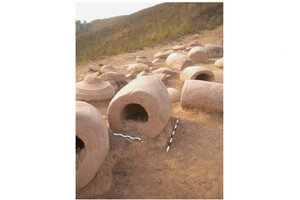Researchers begin to crack the mystery of Laos's 'Plain of Jars'
In central Laos, thousands of stone pots litter hundreds of square miles. One team of Australian archaeologists collaborating with the government believes the pots might have contained human remains.

Phu Da Phor, Phou Khoun District, Luang Prabang Province, Lao PDR. Pink sandstone jars and discs. Phu Da Phor is one of the most inaccessible sites at the Plain of Jars and requires access by a variety of vehicles, including a narrow boat.
Lia Genovese (2014).
An ancient site in Laos, known as the Plain of Jars, is finally beginning to give up its secrets, as the first major excavation effort since the 1930s digs into its mysteries.
Strewn over hundreds of square miles in central Laos, thousands of ceramic jars ranging from three to nine feet in height pepper the landscape, scattered in clusters of anywhere between one and 400 individual pieces.
The Plain of Jars, rendered largely inaccessible by the Vietnam War and unexploded ordnance, is now the subject of a five-year collaborative project between the Laos government and Australian scientists – and the indications so far are that the jars served a morbid purpose.
"The importance of this new work cannot be underestimated," says Lia Genovese, who has researched the Plain of Jars extensively but was uninvolved in this latest study, in an e-mail interview with The Christian Science Monitor. "It is the beginning of a new era that will shed light on the Plain of Jars."
In the latest excavations, which took place in February, archaeologists uncovered human remains estimated to be 2,500 years old – helping to at least date a site whose purpose and origins have largely eluded scientific investigation.
One prevalent theory has been that the artifacts had to do with burial rituals, but until now, the only substantial human remains to have been found were two skulls, four long bones and 10 bone fragments, all piled in a burial pit, as Dr. Genovese, currently a lecturer in social sciences and anthropology at Thammasat University, in Bangkok, Thailand, explains to the Monitor.
"The skeletons uncovered in this new work attest to the cemetery function, but the mystery still remains as to the function of the stone jars, the heaviest of which is carved from one single piece of sandstone which the British geologist Jeremy Baldock has estimated at around 32 tonnes," says Genovese, who teaches about the cultural heritage of Southeast Asia.
And while the specific function of these jars is still to be determined, those involved in the most recent work have their theories.
One such theory is that the pots were actually used for decomposition, as lead researcher Dougald O'Reilly of Australian National University in Canberra explained in a statement.
The professor hypothesized that once the process was complete, the bones would then be buried nearby. But whatever the details, he is now convinced that the jars "were used for the disposal of the dead."
The Plain of Jars – a misnomer, as the area actually contains forests, hills and valleys – is currently being pushed by the Laos government for consideration as a UNESCO World Heritage site, a designation that would confer preservation benefits and recognition, as well as boosting tourism.
Going forward, the archaeologists plan to carry out various scientific tests, and there is also the hope that they may gain access to a haul of artifacts removed from the Plain of Jars in the 1930s, currently stored in Hanoi, Vietnam, at the National Museum of Vietnamese History.
"The lab analyses, including carbon dating, will dramatically enrich our understanding of this area in terms of ancient societies, and their customs, including burial practices," says Genovese. "I have no doubt that it will place the Plain of Jars firmly in mainstream Southeast Asian archaeology."

